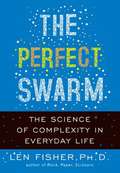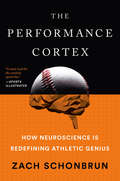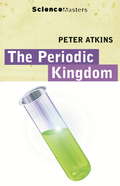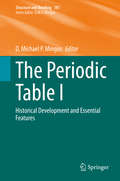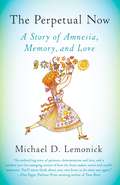- Table View
- List View
The Perfect Predator: A Scientist's Race to Save Her Husband from a Deadly Superbug: A Memoir
by Teresa Barker Steffanie Strathdee Thomas PattersonA riveting memoir of one woman's extraordinary effort to save her husband's life-and the discovery of a forgotten cure that has the potential to save millions more.Epidemiologist Steffanie Strathdee and her husband, psychologist Tom Patterson, were vacationing in Egypt when Tom came down with a stomach bug. What at first seemed like a case of food poisoning quickly turned critical, and by the time Tom had been transferred via emergency medevac to the world-class medical center at UC San Diego, where both he and Steffanie worked, blood work revealed why modern medicine was failing: Tom was fighting one of the most dangerous, antibiotic- resistant bacteria in the world.Frantic, Steffanie combed through research old and new and came across phage therapy: the idea that the right virus, aka "the perfect predator," can kill even the most lethal bacteria. Phage treatment had fallen out of favor almost 100 years ago, after antibiotic use went mainstream. Now, with time running out, Steffanie appealed to phage researchers all over the world for help. She found allies at the FDA, researchers from Texas A&M, and a clandestine Navy biomedical center-and together they resurrected a forgotten cure.A nail-biting medical mystery, The Perfect Predator is a story of love and survival against all odds, and the (re)discovery of a powerful new weapon in the global superbug crisis.
The Perfect Swarm: The Science of Complexity in Everyday Life
by Len FisherOne of the greatest discoveries of recent times is that the complex patterns we find in life are often produced when all of the individuals in a group follow the same simple rule. This process of "self-organization” reveals itself in the inanimate worlds of crystals and seashells, but as Len Fisher shows, it is also evident in living organisms, from fish to ants to human beings. The coordinated movements of fish in shoals, for example, arise from the simple rule: "Follow the fish in front. ” Traffic flow arises from simple rules: "Keep your distance” and "Keep to the right. ” Now, in his new book, Fisher shows how we can manage our complex social lives in an ever more chaotic world. His investigation encompasses topics ranging from "swarm intelligence” to the science of parties and the best ways to start a fad. Finally, Fisher sheds light on the beauty and utility of complexity theory. An entertaining journey into the science of everyday life, The Perfect Swarm will delight anyone who wants to understand the complex situations in which we so often find ourselves.
The Perfect Theory: A Century of Geniuses and the Battle over General Relativity
by Pedro G. Ferreira&“One of the best popular accounts of how Einstein and his followers have been trying to explain the universe for decades&” (Kirkus Reviews, starred review). Physicists have been exploring, debating, and questioning the general theory of relativity ever since Albert Einstein first presented it in 1915. This has driven their work to unveil the universe&’s surprising secrets even further, and many believe more wonders remain hidden within the theory&’s tangle of equations, waiting to be exposed. In this sweeping narrative of science and culture, an astrophysicist brings general relativity to life through the story of the brilliant physicists, mathematicians, and astronomers who have taken up its challenge. For these scientists, the theory has been both a treasure trove and an enigma. Einstein&’s theory, which explains the relationships among gravity, space, and time, is possibly the most perfect intellectual achievement of modern physics—yet studying it has always been a controversial endeavor. Relativists were the target of persecution in Hitler&’s Germany, hounded in Stalin&’s Russia, and disdained in 1950s America. Even today, PhD students are warned that specializing in general relativity will make them unemployable. Still, general relativity has flourished, delivering key insights into our understanding of the origin of time and the evolution of all the stars and galaxies in the cosmos. Its adherents have revealed what lies at the farthest reaches of the universe, shed light on the smallest scales of existence, and explained how the fabric of reality emerges. Dark matter, dark energy, black holes, and string theory are all progeny of Einstein&’s theory. In the midst of a momentous transformation in modern physics, as scientists look farther and more clearly into space than ever before, The Perfect Theory exposes the greater relevance of general relativity, showing us where it started, where it has led—and where it can still take us.
The Perfect Theory: A Century of Geniuses and the Battle over General Relativity
by Professor Pedro G. FerreiraAlbert Einstein's General Theory of Relativity is possibly the most perfect intellectual achievement in modern physics. Anything that involves gravity, the force that powers everything on the largest, hottest or densest of scales, can be explained by it. From the moment Einstein first proposed the theory in 1915, it was received with enthusiasm yet also with tremendous resistance, and for the following ninety years was the source of a series of feuds, vendettas, ideological battles and persecutions featuring a colourful cast of characters. A gripping, vividly told story, A Perfect Theory entangles itself with the flashpoints of modern history and is the first complete popular history of the theory, showing how it has informed our understanding of exactly what the universe is made of and how much is still undiscovered: from the work of the giant telescopes in the deserts of Chile to our newest ideas about black holes and the Large Hadron Collider deep under French and Swiss soil.
The Perfect Wave
by Heinrich PasAlmost weightless and able to pass through the densest materials with ease, neutrinos seem to defy the laws of nature. But these mysterious particles may hold the key to our deepest questions about the universe, says physicist Heinrich Pas. In "The Perfect Wave," Pas serves as our fluent, deeply knowledgeable guide to a particle world that tests the boundaries of space, time, and human knowledge. The existence of the neutrino was first proposed in 1930, but decades passed before one was detected. Pas animates the philosophical and scientific developments that led to and have followed from this seminal discovery, ranging from familiar topics of relativity and quantum mechanics to more speculative theories about dark energy and supersymmetry. Many cutting-edge topics in neutrino research--conjectures about the origin of matter, extra-dimensional spacetime, and the possibility of time travel--remain unproven. But Pas describes the ambitious projects under way that may confirm them, including accelerator experiments at CERN and Fermilab, huge subterranean telescopes designed to detect high-energy neutrino radiation, and the Planck space observatory scheduled to investigate the role of neutrinos in cosmic evolution. As Pass history of the neutrino illustrates, what is now established fact often sounded wildly implausible and unnatural when first proposed. The radical side of physics is both an exciting and an essential part of scientific progress, and "The Perfect Wave" renders it accessible to the interested reader.
The Perfection of Nature: Animals, Breeding, and Race in the Renaissance
by Mackenzie CooleyA deep history of how Renaissance Italy and the Spanish empire were shaped by a lingering fascination with breeding. The Renaissance is celebrated for the belief that individuals could fashion themselves to greatness, but there is a dark undercurrent to this fêted era of history. The same men and women who offered profound advancements in European understanding of the human condition—and laid the foundations of the Scientific Revolution—were also obsessed with controlling that condition and the wider natural world. Tracing early modern artisanal practice, Mackenzie Cooley shows how the idea of race and theories of inheritance developed through animal breeding in the shadow of the Spanish Empire. While one strand of the Renaissance celebrated a liberal view of human potential, another limited it by biology, reducing man to beast and prince to stud. “Race,” Cooley explains, first referred to animal stock honed through breeding. To those who invented the concept, race was not inflexible, but the fragile result of reproductive work. As the Spanish empire expanded, the concept of race moved from nonhuman to human animals. Cooley reveals how, as the dangerous idea of controlled reproduction was brought to life again and again, a rich, complex, and ever-shifting language of race and breeding was born. Adding nuance and historical context to discussions of race and human and animal relations, The Perfection of Nature provides a close reading of undertheorized notions of generation and its discontents in the more-than-human world.
The Perfectionism Workbook: Proven Strategies to End Procrastination, Accept Yourself, and Achieve Your Goals
by Taylor Newendorp MA, LCPCThe Perfectionism Workbook offers actionable exercises to help you overcome the barriers created by perfectionism and develop skills for living a healthier, more gratifying life.The desire to continuously improve can be a positive trait that fuels success. However, those same aspirations can also turn into perfectionism, which causes us to put unrealistic pressure on ourselves and set impossible standards that negatively influence how we think and act.In his work as a clinical therapist, Taylor Newendorp has successfully used cognitive behavioral therapy (CBT) to help countless patients who live with the immense pressure of perfectionism and other related issues such as OCD, anxiety disorders, eating disorders, or depression. In The Perfectionism Workbook, Taylor delivers practical, effective exercises to help you change the way you view yourself, set healthy goals, and find contentment in your daily life.The Perfectionism Workbook is a hands-on guide especially designed to identify and resolve the root causes of perfectionism. It these pages you will find:A perfectionism overview that will help you understand the illusion of perfectionism, why it doesn't work, and what you can do to treat your perfectionism.The 5 tendencies of toxic perfectionism: Need for approval and pleasing others; Procrastination, inaction, and paralysis; Fear of making mistakes; Highly self-critical; Judgment of self and others.Practical strategies based on the principles of CBT, mindfulness, and acceptance that will help you quiet your critical inner voice, conquer procrastination, and develop true self-worth.Real-world examples of perfectionism that will provide meaningful opportunity for insight and reflection into your own perfectionism.Perfectionism can have serious consequences, both mentally and physically. But there is a solution—and it can be found in the pages of The Perfectionism Workbook.
The Performance Cortex: How Neuroscience Is Redefining Athletic Genius
by Zach Schonbrun“A must-read for the cerebral sports fan…like Moneyball except nerdier. Much nerdier.” --Sports IllustratedWhy couldn't Michael Jordan, master athlete that he was, crush a baseball? Why can't modern robotics come close to replicating the dexterity of a five-year-old? Why do good quarterbacks always seem to know where their receivers are?On a quest to discover what actually drives human movement and its spectacular potential, journalist, sports writer, and fan Zach Schonbrun interviewed experts on motor control around the world. The trail begins with the groundbreaking work of two neuroscientists in Major League Baseball who are upending the traditional ways scouts evaluate the speed with which great players read a pitch. Across all sports, new theories and revolutionary technology are revealing how the brain's motor control system works in extraordinary talented athletes like Stephen Curry, Tom Brady, Serena Williams, and Lionel Messi; as well as musical virtuosos, dancers, rock climbers, race-car drivers, and more.Whether it is timing a 95 mph fastball or reaching for a coffee mug, movement requires a complex suite of computations that many take for granted--until they read The Performance Cortex. Zach Schonbrun ushers in a new way of thinking about the athletic gifts we marvel over and seek to develop in our own lives. It's not about the million-dollar arm anymore. It's about the million-dollar brain.
The Performance: A Novel
by Claire Thomas'Quietly transformational'The Times 'A tour de force... I can't recommend this too highly'Patrick Gale'Innovative... an original, at-a-sitting read'Daily Mail'A potent meditation on the intensity of women's lives'Charlotte Wood, author of The Weekend'A miracle... Engaging and evocative'Washington Post'I loved and admired The Performance... Unmissable'Emma Stonex, author of The Lamplighters'Lively and intimate... The way Thomas plays with the reader is a sort of genius'Guardian'Thomas writes these women with such wisdom and compassion, that by the end we are all transformed'Claire Fuller, author of Unsettled Ground The false cold of the theatre makes it hard to imagine the heavy wind outside in the real world, the ash air pressing onto the city from the nearby hills where bushfires are taking hold.The house lights lower.The auditorium feels hopeful in the darkness.As bushfires rage outside the city, three women watch a performance of a Beckett play.Margot is a successful professor, preoccupied by her fraught relationship with her ailing husband. Ivy is a philanthropist with a troubled past, distracted by the snoring man beside her. Summer is a young theatre usher, anxious about the safety of her girlfriend in the fire zone.As the performance unfolds, so does each woman's story. By the time the curtain falls, they will all have a new understanding of the world beyond the stage.
The Perfume Lover: A Personal History of Scent
by Denyse BeaulieuThe Perfume Lover is a candid personal account of the process of composing a fragrance, filled with sensual scent descriptions, sexy tidbits, and historical vignettes.What if the most beautiful night in your life inspired a perfume? When Denyse Beaulieu was growing up near Montreal, perfume was forbidden in her house, spurring a childhood curiosity that became an intellectual and sensual passion. It is this passion she pursued all the way to Paris, where she now lives, and which led her to become a respected fragrance writer. But little did she know that it would also lead her to achieve a perfume lover's wildest dream: When Denyse tells famous perfumer Betrand Duchaufour at L'Artisan Parfumeur of a sensual night spent in Seville under a blossoming orange tree, wrapped in the arms of a beautiful man, the story stirs his imagination and together they create a scent that captures the essence of that night. As their unique creative collaboration unfolds, the perfume-in-progress conjures intimate memories, leading Beaulieu to make sense of her life through scents. Throughout the book, she weaves the evocative history of perfumery into her personal journey, in an intensely passionate voice: the masters and the masterpieces, the myths and the myth-busting, down to the molecular mysteries that weld our flesh to flowers.Now, just to set your nostrils aquiver: Séville à l'aube is an orange blossom oriental with zesty, green and balsamic effects, with notes of petitgrain, petitgrain citronnier, orange blossom, beeswax, incense, and lavender, and is now available at fragrance outlets in the U.S.
The Period Positivity Book: A Guide to Understanding, Owning and Celebrating Your Period
by Claire ChamberlainEmbrace period positivity and get to know your cycle with this frank and empowering guide to menstrual health. This book is here to open up the conversation, break the taboo, and answer the questions you were too afraid to ask. Through tips and invaluable advice, you'll learn everything you need to know about how your period affects you.
The Periodic Kingdom: A Journey Into The Land Of The Chemical Elements (Science Master)
by P. W. AtkinsCome on a journey into the heart of matter--and enjoy the process!--as a brilliant scientist and entertaining tour guide takes you on a fascinating voyage through the Periodic Kingdom, the world of the elements. The periodic table, your map for this trip, is the most important concept in chemistry. It hangs in classrooms and labs throughout the world, providing support for students, suggesting new avenues of research for professionals, succinctly organizing the whole of chemistry. The one hundred or so elements listed in the table make up everything in the universe, from microscopic organisms to distant planets. Just how does the periodic table help us make sense of the world around us? Using vivid imagery, ingenious analogies, and liberal doses of humor P. W. Atkins answers this question. He shows us that the Periodic Kingdom is a systematic place. Detailing the geography, history and governing institutions of this imaginary landscape, he demonstrates how physical similarities can point to deeper affinities, and how the location of an element can be used to predict its properties. Here’s an opportunity to discover a rich kingdom of the imagination kingdom of which our own world is a manifestation.
The Periodic Kingdom: A Journey Into the Land of the Chemical Elements (SCIENCE MASTERS)
by Peter AtkinsA 'travel guide' to the periodic table, explaining the history, geography and the rules of behaviour in this imagined land.The Periodic Kingdom is a journey of imagination in which Peter Atkins treats the periodic table of elements - the 109 chemical elements in the world, from which everything is made - as a country, a periodic kingdom, each region of which corresponds to an element. Arranged much like a travel guide, the book introduces the reader to the general features of the table, the history of the elements, and the underlying arrangement of the table in terms of the structure and properties of atoms.Atkins sees elements as finely balanced living personalities, with quirks of character and certain, not always outward, dispositions, and the kingdom is thus a land of intellectual satisfaction and infinite delight.
The Periodic Table
by Paul ParsonsAs one of the most recognizable images in science, the periodic table is ingrained in our culture. First drawn up in 1869 by Dmitri Mendeleev, its 118 elements make up not only everything on our planet but also everything in the entire universe.The Periodic Table looks at the fascinating story and surprising uses of each of those elements, whether solid, liquid or gas. From the little-known uses of gold in medicine to the development of the hydrogen bomb, each entry is accompanied by technical data (category, atomic number, weight, boiling point) presented in easy-to-read headers, and a colour coding system that helps the reader to navigate through the different groups of elements.A remarkable display of thought-provoking science and beautiful photography, this guide will allow the reader to discover the world afresh.
The Periodic Table (A Very Short Introduction)
by Eric R. ScerriIn this Very Short Introduction Eric R. Scerri looks at the trends in properties of elements that led to the construction of the table, and shows how the deeper meaning of the table's structure gradually became apparent with the development of atomic theory and, in particular, quantum mechanics, which underlies the behaviour of all of the elements and their compounds.
The Periodic Table (Comic Strip Science #5)
by Paul MasonComic Strip Science: The Periodic Table makes learning about science fun! Each spread features a short, funny comic strip related to the periodic table. Discover which element started a war among dentists, why diamonds aren't forever and the freaky story of how phosphorous was discovered. Around the strips, diagrams and panels give further information on the topic. They are a fantastic way to engage children aged 8 plus with science.The illustrator, Jess Bradey, is winner of the 2021 Blue Peter Award for Best Non-Fiction for A Day in the Life of a Poo, Gnu and You and also writes and draws for The Phoneix Comic. Titles in the series: Biology, Chemistry, Earth and Space, Physics, The Periodic Table.
The Periodic Table I: Historical Development and Essential Features (Structure and Bonding #181)
by D. Michael P. MingosAs 2019 has been declared the International Year of the Periodic Table, it is appropriate that Structure and Bonding marks this anniversary with two special volumes.In 1869 Dmitri Ivanovitch Mendeleev first proposed his periodic table of the elements. He is given the major credit for proposing the conceptual framework used by chemists to systematically inter-relate the chemical properties of the elements. However, the concept of periodicity evolved in distinct stages and was the culmination of work by other chemists over several decades. For example, Newland’s Law of Octaves marked an important step in the evolution of the periodic system since it represented the first clear statement that the properties of the elements repeated after intervals of 8. Mendeleev’s predictions demonstrated in an impressive manner how the periodic table could be used to predict the occurrence and properties of new elements. Not all of his many predictions proved to be valid, but the discovery of scandium, gallium and germanium represented sufficient vindication of its utility and they cemented its enduring influence. Mendeleev’s periodic table was based on the atomic weights of the elements and it was another 50 years before Moseley established that it was the atomic number of the elements, that was the fundamental parameter and this led to the prediction of further elements. Some have suggested that the periodic table is one of the most fruitful ideas in modern science and that it is comparable to Darwin’s theory of evolution by natural selection, proposed at approximately the same time. There is no doubt that the periodic table occupies a central position in chemistry. In its modern form it is reproduced in most undergraduate inorganic textbooks and is present in almost every chemistry lecture room and classroom. This first volume provides chemists with an account of the historical development of the Periodic Table and an overview of how the Periodic Table has evolved over the last 150 years. It also illustrates how it has guided the research programmes of some distinguished chemists.
The Periodic Table II: Catalytic, Materials, Biological and Medical Applications (Structure and Bonding #182)
by D. Michael P. MingosAs 2019 has been declared the International Year of the Periodic Table, it is appropriate that Structure and Bonding marks this anniversary with two special volumes.In 1869 Dmitri Ivanovitch Mendeleev first proposed his periodic table of the elements. He is given the major credit for proposing the conceptual framework used by chemists to systematically inter-relate the chemical properties of the elements. However, the concept of periodicity evolved in distinct stages and was the culmination of work by other chemists over several decades. For example, Newland’s Law of Octaves marked an important step in the evolution of the periodic system since it represented the first clear statement that the properties of the elements repeated after intervals of 8. Mendeleev’s predictions demonstrated in an impressive manner how the periodic table could be used to predict the occurrence and properties of new elements. Not all of his many predictions proved to be valid, but the discovery of scandium, gallium and germanium represented sufficient vindication of its utility and they cemented its enduring influence. Mendeleev’s periodic table was based on the atomic weights of the elements and it was another 50 years before Moseley established that it was the atomic number of the elements, that was the fundamental parameter and this led to the prediction of further elements. Some have suggested that the periodic table is one of the most fruitful ideas in modern science and that it is comparable to Darwin’s theory of evolution by natural selection, proposed at approximately the same time. There is no doubt that the periodic table occupies a central position in chemistry. In its modern form it is reproduced in most undergraduate inorganic textbooks and is present in almost every chemistry lecture room and classroom. This second volume provides chemists with an overview of the important role played by the Periodic Table in advancing our knowledge of solid state and bioinorganic chemistry. It also illustrates how it has been used to fine-tune the properties of compounds which have found commercial applications in catalysis, electronics, ceramics and in medicinal chemistry.
The Periodic Table for Young Scientists (Your Expert Guide #1)
by Dr Dr Kit ChapmanFrom a top expert in the world of science comes this definitive guide to the Periodic Table, published in partnership with the Royal Society of Chemistry.In Your Expert Guide: The Periodic Table, discover the origins and genius of the Periodic Table: how the idea came about, what each symbol means and how it underpins our understanding of matter, materials and the study of chemistry. Explore the elements at work in our world and get a clear picture of the Periodic Table's role in explaining the building blocks of the Universe.Written by Dr Kit Chapman, award-winning science journalist, academic at Falmouth University and global science communicator. Published in partnership with The Royal Society of Chemistry, the internationally renowned nonprofit organisation with the same mission since 1841: to advance excellence in the chemical sciences. With lovely artwork by Dao Linh, see the elements come alive for curious readers aged 8+.Books in the Your Expert Guide series:With the Royal Society of Chemistry: The Periodic Table and Chemistry for Young ScientistsWith the Royal Society of Biology: The Human Body and Biology for Young ScientistsWith the Institute of Physics: The Universe for Kids and Physics for Young Scientists
The Periodic Table in Minutes (In Minutes)
by Dan GreenAn icon of science, the Periodic Table defines the fundamental chemistry of everything in the universe. In this compact yet comprehensive guide, Dan Green outlines the history, development and workings of the table, shows how its design reflects and illuminates the organisation of all matter, and even explains what it has to tell us about the chemistry of distant stars and of our own bodies. Contents include an individual entry for every known element? detailing properties, uses and key data, and sections on the patterns and groups of the famous table, as well as explanations of basic chemistry concepts such as elements and compounds, atomic structure, chemical bonds, reactions and radioactivity, amongst many others.
The Periodic Table: A Field Guide to the Elements
by Paul Parsons Gail DixonThe Periodic Table is one of the most recognizable images in science - and in our culture. Its 118 elements make up everything on our planet and in the entire universe. But how many of us actually know how to interpret its distinctive design? And what does its unique arrangement tell us about the behaviour of each element in the world around us? The Periodic Table looks at the fascinating story and surprising history of each of these elements, from the little-known uses of gold in medicine to that of arsenic as a wallpaper dye in the ninteenth-century and the development of the hydrogen bomb. Packed with interesting facts and figures and helpful illustrations, this accessible guide will help the armchair chemist navigate through the different groups of elements - and discover the world afresh.
The Periodic Table: A Field Guide to the Elements
by Paul Parsons Gail DixonThe Periodic Table is one of the most recognizable images in science - and in our culture. Its 118 elements make up everything on our planet and in the entire universe. But how many of us actually know how to interpret its distinctive design? And what does its unique arrangement tell us about the behaviour of each element in the world around us? The Periodic Table looks at the fascinating story and surprising history of each of these elements, from the little-known uses of gold in medicine to that of arsenic as a wallpaper dye in the ninteenth-century and the development of the hydrogen bomb. Packed with interesting facts and figures and helpful illustrations, this accessible guide will help the armchair chemist navigate through the different groups of elements - and discover the world afresh.
The Perpetual Now: A Story of Amnesia, Memory, and Love
by Michael D. LemonickIn the aftermath of a shattering illness, Lonni Sue Johnson lives in a "perpetual now," where she has almost no memories of the past and a nearly complete inability to form new ones. The Perpetual Now is the moving story of this exceptional woman, and the groundbreaking revelations about memory, learning, and consciousness her unique case has uncovered. Lonni Sue Johnson was a renowned artist who regularly produced covers for The New Yorker, a gifted musician, a skilled amateur pilot, and a joyful presence to all who knew her. But in late 2007, she contracted encephalitis. The disease burned through her hippocampus like wildfire, leaving her severely amnesic, living in a present that rarely progresses beyond ten to fifteen minutes. Remarkably, she still retains much of the intellect and artistic skills from her previous life, but it's not at all clear how closely her consciousness resembles yours or mine. As such, Lonni Sue's story has become part of a much larger scientific narrative—one that is currently challenging traditional wisdom about how human memory and awareness are stored in the brain. In this probing, compassionate, and illuminating book, award-winning science journalist Michael D. Lemonick uses the unique drama of Lonni Sue Johnson's day-to-day life to give us a nuanced and intimate understanding of the science that lies at the very heart of human nature.
The Perpetuation of Living Beings
by Thomas Henry HuxleyEarly scientific work on heredity variance and genetic transmission.
The Persecuted Drug: The Story of DMSO
by Pat McgradyDMSO remains a truly amazing substance. It is a versatile solvent; it probably will dissolve more chemicals than any other solvent. It penetrates the skin and is in the bloodstream within seconds; and it carries many dissolved chemicals with it. It freezes at a couple of degrees below room temperature. As a runoff product of the paper industry, it is abundant and should be cheap. (With inflation and the middleman's profits, its price during the last half-dozen years has multiplied thirty fold. But considering its many uses, it still is cheap at the current $10 a pint.)

